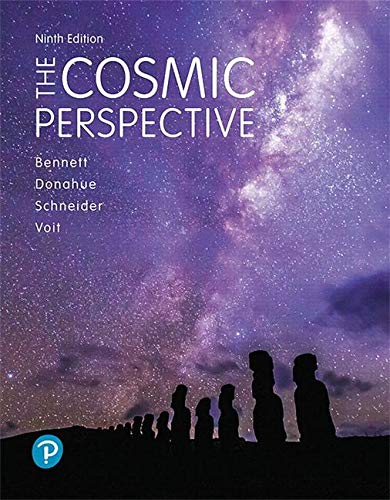
The Cosmic Perspective (9th Edition)
9th Edition
ISBN: 9780134874364
Author: Jeffrey O. Bennett, Megan O. Donahue, Nicholas Schneider, Mark Voit
Publisher: PEARSON
expand_more
expand_more
format_list_bulleted
Textbook Question
Chapter 13, Problem 6EAP
How does the transit method work’ What was the Kepler mission?
Expert Solution & Answer
Want to see the full answer?
Check out a sample textbook solution
Students have asked these similar questions
A pendulum has a 0.4-m-long cord and is given a tangential velocity of 0.2 m/s toward the
vertical from a position 0 = 0.3 rad.
Part A
Determine the equation which describes the angular motion.
Express your answer in terms of the variable t. Express coefficients in radians to three significant figures.
ΜΕ ΑΣΦ
vec
(t)=0.3 cos (4.95t) + 0.101 sin (4.95t)
Submit Previous Answers Request Answer
× Incorrect; Try Again; 6 attempts remaining
Part A
■Review
The uniform 150-lb stone (rectangular block) is being turned over on its side by pulling the
vertical cable slowly upward until the stone begins to tip.
(Figure 1)
If it then falls freely (T = 0) from an essentially balanced at-rest position, determine the speed at which the corner A strikes the pad at B. The stone does not slip at its corner C as it falls. Suppose that height of the stone is
L = 1.2 ft.
Express your answer to three significant figures and include the appropriate units.
?
ft
VA 10.76
S
Submit Previous Answers Request Answer
× Incorrect; Try Again; 6 attempts remaining
Consider the circuit shown in the figure. The battery has emf ε = 69 volts and negligible internal resistance. The inductance is L = 0.4 H and the resistances are R 1 = 12 Ω and R 2 = 9.0 Ω. Initially the switch S is open and no currents flow. Then the switch is closed. After leaving the switch closed for a very long time, it is opened again. Just after it is opened, what is the current in R 1?
Chapter 13 Solutions
The Cosmic Perspective (9th Edition)
Ch. 13 - Prob. 1VSCCh. 13 - Prob. 2VSCCh. 13 - Prob. 3VSCCh. 13 - Prob. 4VSCCh. 13 - Prob. 5VSCCh. 13 - I. Why are extrasolar planets hard to detect...Ch. 13 - 2. What are the two major approaches to detecting...Ch. 13 - 3. How can gravitational lugs from orbiting...Ch. 13 - Prob. 4EAPCh. 13 - Briefly describe Ihe Doppler method. Summarize the...
Ch. 13 - How does the transit method work’ What was the...Ch. 13 - Prob. 7EAPCh. 13 - Prob. 8EAPCh. 13 - Prob. 9EAPCh. 13 - Prob. 10EAPCh. 13 - Prob. 11EAPCh. 13 - Prob. 12EAPCh. 13 - Prob. 13EAPCh. 13 - Prob. 14EAPCh. 13 - Prob. 15EAPCh. 13 - Prob. 16EAPCh. 13 - Prob. 17EAPCh. 13 - Prob. 18EAPCh. 13 - Prob. 19EAPCh. 13 - Decide whether the statement makes sense lor is...Ch. 13 - Prob. 21EAPCh. 13 - Prob. 22EAPCh. 13 - Prob. 23EAPCh. 13 - Prob. 24EAPCh. 13 - Decide whether the statement makes sense lor is...Ch. 13 - Prob. 26EAPCh. 13 - Prob. 27EAPCh. 13 - Choose Lhe best ansuter to each of the following....Ch. 13 - Choose Lhe best ansuter to each of the following....Ch. 13 - Choose Lhe best ansuter to each of the following....Ch. 13 - Choose Lhe best ansuter to each of the following....Ch. 13 - Choose Lhe best ansuter to each of the following....Ch. 13 - Choose Lhe best ansuter to each of the following....Ch. 13 - Choose Lhe best ansuter to each of the following....Ch. 13 - Choose Lhe best ansuter to each of the following....Ch. 13 - Choose Lhe best ansuter to each of the following....Ch. 13 - Choose Lhe best ansuter to each of the following....Ch. 13 - When is a Theory Wrong? As discussed in this...Ch. 13 - Prob. 40EAPCh. 13 - Prob. 42EAPCh. 13 - Prob. 43EAPCh. 13 - Comparing Methods. What are the strengths and...Ch. 13 - No Hot Jupiters Here. How do we think hot Jupiters...Ch. 13 - Prob. 46EAPCh. 13 - Prob. 47EAPCh. 13 - Lost in the Glare. This exercise helps you...Ch. 13 - Transit of TrES-1. The planet TrES-1, orbiting a...Ch. 13 - Planet Around 51 Pegasi. The star 51 Pegasi has...Ch. 13 - Identical Planets? Imagine two planets orbiting a...
Knowledge Booster
Learn more about
Need a deep-dive on the concept behind this application? Look no further. Learn more about this topic, physics and related others by exploring similar questions and additional content below.Similar questions
- A capacitor with a capacitance of C = 5.95×10−5 F is charged by connecting it to a 12.5 −V battery. The capacitor is then disconnected from the battery and connected across an inductor with an inductance of L = 1.55 H . At the time 2.35×10−2 s after the connection to the inductor is made, what is the current in the inductor? At that time, how much electrical energy is stored in the inductor?arrow_forwardCan someone help me with this question. Thanks.arrow_forwardCan someone help me with this question. Thanks.arrow_forward
arrow_back_ios
SEE MORE QUESTIONS
arrow_forward_ios
Recommended textbooks for you
 Physics for Scientists and Engineers: Foundations...PhysicsISBN:9781133939146Author:Katz, Debora M.Publisher:Cengage Learning
Physics for Scientists and Engineers: Foundations...PhysicsISBN:9781133939146Author:Katz, Debora M.Publisher:Cengage Learning AstronomyPhysicsISBN:9781938168284Author:Andrew Fraknoi; David Morrison; Sidney C. WolffPublisher:OpenStax
AstronomyPhysicsISBN:9781938168284Author:Andrew Fraknoi; David Morrison; Sidney C. WolffPublisher:OpenStax
 Stars and GalaxiesPhysicsISBN:9781305120785Author:Michael A. Seeds, Dana BackmanPublisher:Cengage Learning
Stars and GalaxiesPhysicsISBN:9781305120785Author:Michael A. Seeds, Dana BackmanPublisher:Cengage Learning Foundations of Astronomy (MindTap Course List)PhysicsISBN:9781337399920Author:Michael A. Seeds, Dana BackmanPublisher:Cengage Learning
Foundations of Astronomy (MindTap Course List)PhysicsISBN:9781337399920Author:Michael A. Seeds, Dana BackmanPublisher:Cengage Learning

Physics for Scientists and Engineers: Foundations...
Physics
ISBN:9781133939146
Author:Katz, Debora M.
Publisher:Cengage Learning

Astronomy
Physics
ISBN:9781938168284
Author:Andrew Fraknoi; David Morrison; Sidney C. Wolff
Publisher:OpenStax


Stars and Galaxies
Physics
ISBN:9781305120785
Author:Michael A. Seeds, Dana Backman
Publisher:Cengage Learning

Foundations of Astronomy (MindTap Course List)
Physics
ISBN:9781337399920
Author:Michael A. Seeds, Dana Backman
Publisher:Cengage Learning

Kepler's Three Laws Explained; Author: PhysicsHigh;https://www.youtube.com/watch?v=kyR6EO_RMKE;License: Standard YouTube License, CC-BY